Fanny Burney
Early in our second week in Tuscany, we took the train to Pistoia, the nearest larger city . Travelling by train in Italy is very simple and reasonably inexpensive. Compared to the cost of fuel, parking and the intangibles such as dealing with city traffic, train travel is an attractive alternative. Pistoia is often overlooked by those visiting Tuscany, and a well kept secret. Most tend to do the big three, Florence, Siena and Pisa and concentrate on the hill towns – such as Montepulciano, Montalcino, Monteriggioni, San Gimignano and Cortona. Fortunately, we had covered most of them on a previous trip to Italy so this time we were concentrating on the lesser visited northern part of Tuscany.
Pistoia [population ~100,000] has a reasonably long history - possibly dating back to the Etruscans but historians have at least confirmed that the Romans were certainly here. However, it really hit its straps in the 12th and 13th centuries. Often you will find the central piazza is built around the cathedral [or whatever grade of church dictated by the size of the town] which is then accompanied by the local governing authority's palazzo and the central administration building for that locality . [This is very similar to the Plaza des Armes that we struck in many South American cities]. Pistoia’s Piazza del Duomo is no different, with the Cattedrale di S. Zeno e Campanile [Bell Tower], City Hall, Magisterial Palace and a city administrative building completing the box. Off to one side in the corner of the piazza is the Torre di Catalina, a fine example of a medieval tower house. Surprisingly, however, the city itself considers the adjacent Piazza della Sala to be the heart of the city. This small piazza is the site of the regular fruit and vegetable market. Perhaps food is far more important to the Pistoiese than religion or civil administration. Nearby in Via Camilo Benso Cavour is the Chiesa di S. Giovanni Fuorcivitas which, with its Hawkes Bay rugby jersey stripes, looks very similar to Siena’s Duomo. We meandered through the heart of the old city for a couple of hours till the shops closed [1 pm] then stopped for lunch on the edge of the fresh market. People watching is a great way to have an outdoor lunch, particularly if you are on the edge of the market and opt for a slow lunch . Filled in a couple of hours very easily. Most shops don’t reopen till 4 pm so "lunching" till then could be a trap for young players. We can understand the three hour siesta break when it is very hot but when the weather cools down to the low 20s/high teens [as it is now], it doesn’t seem to make a lot of sense because they then remain open till 7 - 8 pm. Must play havoc with productivity and maybe that is one of the reasons why some of the southern Mediterranean countries are having such a tough time economically. Still, for us, a very relaxing day in a very nice town. Well worth a look-see if you are in this part of the world.
Almost forgot our major excitement that day. When you ride the trains in Italy, before boarding, you need to validate your ticket [get it stamped] at a special machine on the platform. Having bought our tickets in Buggiano, we got talking to an elderly English couple who also were staying locally. When the train arrived, we all jumped on, then with the train well under way, we realised that we had forgotten to validate our tickets . Now, if the conductor happens to find that you have not validated your ticket, it is an instant hefty fine. So at the next stop - Montecatini Terme - Stu jumps off the train and runs back to the validation machine to ensure that we are kosher for this ride. We now know that, fortunately, the trains stop there longer because of its spa connections – obviously wealthier people take longer to board trains with all of their luggage, However, we weren't aware of that little gem at that stage. We were in the first carriage and the validation machine was at the other end of the station which at Montecatini, is about 100 metres long. Longest distance Stuey has run since he had his second hip replaced. However, suffice to say, he made it back on board in time and, with Murphy being one of our travelling companions, you guessed it - the train conductor didn’t come round to check our tickets.
The following day we went for a drive to Bagni di Lucca, another spa town north of Lucca . The town is about 45 kms from our Buggiano apartment and depending on the route, the drive can take an hour, or hour and a half. We wanted to slip back to Pescia for a couple of photos, and from there, "Carla"sent us on the slower mountain route. The reason for the extra duration is that the road takes you over hills above Lucca, going from one valley across to the next. The road branched off at Collodi [of Pinocchio fame] and started to climb up the valley beside the Pescia River. There were lots of factories beside the road and it took us a while to establish that they were, in fact, paper mills which were built there to access the water from the river. Clearly, that water gets recycled many times before it gets to the bottom of the valley. The road was a little similar to mountain roads on the west coast of the South Island with bush right to the road edge. Though very winding and very, very narrow at least having to drive so slowly allowed one to take in the scenery - a truly spectacular drive . Lots of pulling over to let the speedier locals pass, trucks included. The surprising thing was that there were several small towns on the top of the ridge line which seemed to have no reason for being there other than to provide a picturesque setting. Bagni di Lucca, back down in the valley on the other side of the hills, is a spa town which in its heyday [18th and 19th centuries] had some reasonably important guests, a European social 'hot spot" in more ways than one. Getting there, however, would have been a challenge in those days because there would have been no sealed roads; obviously the soothing/healing powers of the thermal waters were a major attraction [and probably needed after the trek to the spa although they must have undone all the good therapy on the return leg]. We had lunch in an old restaurant in town - ravioli with shaved black truffles. The ravioli was a little dry and needed a good slug of olive oil but the truffle was divine. The drive home was on the longer but faster route, generally following the large river [the Fiume Serchio] in that valley downstream past some interesting towns and bridges.
Wednesday we spent in Florence for the ‘significant’ birthday and had a lovely day . We had stayed in Florence back in 2006 but had failed to climb up to the top of the Duomo for an overview of the city from the centre so [Stu] felt that a return to Florence was a must. Also after some research, we located a couple of potentials for the significant birthday lunch. Not as easy as it may sound. The tourist industry to a degree has ruined the traditional dining experience, with many restaurants now more focussed on throughput and ambushing the passing traffic than concentrating on their traditional values. Thus far, we have found this to be the case wherever there are high tourist numbers.
For Florence, we again we took the train, knowing that the final stop [Firenze SMN] delivers one on the edge of the city centre. Fortunately, this time we remembered to validate the ticket before we boarded. As an aside, it is obvious that some people do not buy tickets and take a chance on the conductor not coming around before their stop; this day, however, a couple of people got it wrong . Result is that they were fronted to the Police at the next stop and the train proceeded without them. [If like us you have a ticket, but forget to validate, it is only a fine.] On our arrival in Florence, our first task was to find a “caffe” for a coffee. Found one on a side street which had great coffee, wonderful patisseries and even greater prices. One of the best and cheapest morning teas we have had so far. Then off to the Central Market which has about 200 different stall holders. Lots of them sit out front of a regular shop which has the same type of product and we suspect that they are linked. The main items on sale were leather coats/jackets [very good quality], leather bags, leather belts [in fact, just about leather anything, leather being a Florence speciality], scarves and ties, T-Shirts, shoes and tacky tourist stuff [fridge magnets, calendars, etc]. The outside stalls encircle the huge indoor food market - fresh food, bread, cheese, meat, vegetables, fruit and fish. Just off the side of the market is the artists’ section – oils, water colours, pen and ink, you name it, it is there . And the quality is reasonably good.
Then to lunch. We had researched our various books [including our very own guru, Mr Plotkin] looking for something simple but very Tuscan and identified one [Trattoria Mario] which just happened to be off the edge of the central market. The various write ups indicated that it was a favourite with the locals and they were not wrong. However, they had forgotten to add that foreigners had also now discovered it. The first thing you notice [having bypassed the obviously more touristy counterparts with their outdoor seating and fancy table service] is that Mario’s is a small restaurant only one room wide with bench tables, each seating about six . All seating is inside with the maximum at any time being less than 50 [all on stools]. The front window had a number of newspaper articles in different languages raving about the experience of eating at Mario’s [I guess they would if they were in their front window.] However, the next surprise is that you give them your name and they tell you when to return because they only take bookings at the front door and you get seated, in sequence of registering, wherever the next space appears . We arrived about 12.30 and they were in full swing for the day [they don’t do dinners - only lunches]. We were told the wait would be about 40 minutes. So having registered our intent, we headed back to the market to fill in time. Their time estimate was fairly accurate and when we got the call, we ended up being seated with an Italian couple who came from the next town to us here in Buggiano and two young chaps from Melbourne [this was their third lunch at the place]. The Aussies were replaced soon after by a mum/daughter pair from Brazil. We had zuppa di zucchini [zucchini cooked in tomatoes] and tortelli di patate al ragu [pasta with meat sauce]. Both fabulous and suitably matched with a very quaffable house white wine. Other memories of the meal are:
- the size of the T-bone steak – about 40 mm thick and 250 mm long [would feed a family of four – and did] and they only serve it one way – rare.
- the interaction between the kitchen staff and the customers. The kitchen ran along the side of the restaurant and was separated by a glass partition with a serving counter. You could see everything happening in the kitchen and be assured, everything was freshly cooked. Lots of noise particularly when the chef was chopping through the T-Bone rib.
The other reason for visiting Florence was to get photos from the Duomo’s dome. Trish very kindly offered to look after our day packs and have a coffee in a nearby pasticceria while Stuey did the deed for the team. After buying the ticket for the Duomo dome, he joined the queue and after about 15 minutes, he got inside the Duomo only to find that this queue did not lead to the Dome. So back outside and around to the other side of the Duomo to join yet another queue – twice as long and moving half as fast. The officials would only allow groups of about 40 at a time to enter because of the congestion on the common stairway sections and the limited space on the viewing platform on the top of the dome .
45 minutes later – success. Stuey gets to start the climb – all 463 steps of it. Regrettably [for Stuey], these were not little old lady stairs, as his mother used to call them. These were big suckers so whenever you [he] did strike someone descending on the common sections, chivalry was the order of the day to allow them through [and for you [him] to get your [his] breath back]. He took their word for the 463 steps - who wouldn’t when the sign at the start of the climb suggested that if you suffered from a heart condition, vertigo or claustrophobia [and presumably any combination thereof], you should try some other less taxing activity. Not a great selling point but certainly truth in advertising. The view from the top, however, was well worth it [once you [he] had recovered]. The descent was not too much easier, taking about 10 minutes [photo stops excluded]. So about 90 minutes after having set out, Stuey [slightly knackered] gets back to Trish who all the while has been enjoying herself over coffee and patisserie . You can tell who the smart one is on this team. [As an aside, we think all the stairs in the world have decided to come to Italy for the year - we perceive another set lying in wait in Siena.]
The towns/cities that we visited after Milan had lulled us into a false sense regarding tourist numbers although we definitely got a sense of tourist town in Pisa. However, Florence was Pisa on steroids as far as tourists were concerned, bringing back the large tour groups with their “follow me” guides [and their “follow me” umbrellas/flowers/balloons/signs]. It was probably accentuated because in Florence they were confined to the streets whereas in Pisa they were able to spread out a little more over the large grassed areas. While there were many groups of Europeans/Americans, they were outnumbered by the Asian groups. Half of Japan must be currently visiting Florence; of those who climbed the Dome, 75% would have been Asian [predominantly Japanese] . Tourism clearly remains a key economic driver for Florence.
At this point, something for the foodies. The following is a typical Piemonte pasta dish we sampled in a restaurant in Turin - Tajarin con Gorgonzola e Noci [Thin fresh noodles with Gorgonzola and Walnuts]
150 gms gorgonzola
¼ cup light cream
1 tbsp unsalted butter
450 gms taglierini or tagliolini [preferably fresh]
50 gms walnuts [broken into small pieces]
Gently warm together the Gorgonzola, cream and butter until it forms a velvety sauce. DO NOT BOIL. Cook pasta in boiling salted water until al dente. Drain then add to the sauce, toss with the walnut pieces, combine thoroughly, serve immediately. Serves 4 – 6. The locals would serve it with a Carema or Gattinara but any strong body red wine would work equally as well. Enjoy.
Some comments on our Tuscan “home” . As indicated earlier, we are in the countryside. Small farm holdings abound as you make your way up the valley. Above us on our side of the stream is bush and on the top of the ridge line, a couple of bell towers and the Castello Buggiano. Being tucked into the eastern side of the valley, we get only late morning/afternoon sun [which with the recent drop in temperatures is welcome]. Over the last couple of days during our stay, we heard the occasional hunters' rifle/shotgun blasts – we understand that there are wild pigs in the area and this tends to be reflected in local menus having a number of wild pork dishes. The relatively peaceful setting, however, does not apply to the landlady’s turkey and roosters who have a competition about 5.30 each morning and rematches irregularly throughout the day. The latter we don’t mind but the dawn chorus makes sleeping in a challenge.
Finally, we had had some rain over the past couple of nights and yesterday walking into Buggiano, we noticed new carpets of wild miniature cyclamens . Simply enhances an already pleasant country experience.
As indicated at the outset, we had visited Tuscany some years ago, taking in the main centres and the hillside towns. Our aim this time [apart from catching our breath a little] was to visit an area that we were less familiar with and that has been successful. Tomorrow we move on to Umbria and more particularly, Perugia, Assisi and Gubbio. No doubt Umbria will rekindle memories from last year's visit and give us some new ones. We'll keep you posted.
,,,but wait, there's more...
We decided to return to Montecatini Terme for lunch on our last day here in Buggiano. When we ate at Mario's in Florence, one of the people at our table [Alessandro] was the head chef at a restaurant in Montecatini so we thought we would try his place . Well, folks, life just keeps getting better and we now have a new champion for our best meal in Italy. We identified ourselves when we walked in and he recognised us immediately. Don't know whether it was the previous contact or not but our meal was superb. Started with zuppa pomodoro [very rich and thick soup comprising tomato, bread, herb mix] which was amazing. Next, Bacala with fagioli toscanelli [Salted cod with a tomato sauce and white beans]. Finally, when we ordered coffee, out came a selection of small pastries [on the house]. We were keen to get the zuppa recipe and Trish had to do a trade so we gave him her mother's Barbeque Lamb recipe because we noted that he'd had a lamb dish at Mario's. The whole meal was simply divine, the table service excellent, the staff extremely welcoming and cheerful and all that at a reasonable price. So folks, another to add to your bucket list, Osteria Pellegrini in Montecatini Terme.
You can read more reviews on the restaurant on <http://www .tripadvisor.com/Restaurant_Review-g194830-d4288872-Reviews-Pellegrini_s_Osteria_Moderna-Montecatini_Terme_Province_of_Pistoia_Tuscany.html>

 Buggiano, Tuscany, Italy
Buggiano, Tuscany, Italy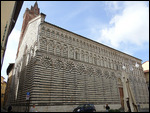
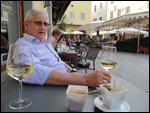
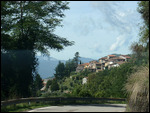
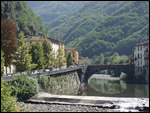


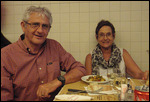
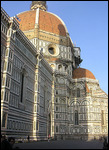
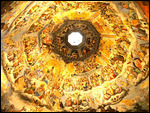
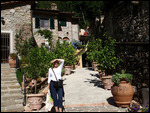

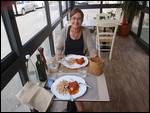
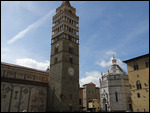
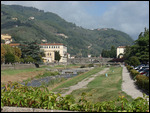
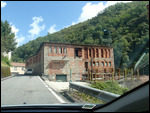
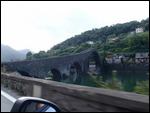
![The Florence Duomo Dome Queue [after 45 minutes]](http://images2.travelark.org/images/sntj/thumbnail.large.1.1379624092.the-duomo-dome-queue-after-45-minutes.jpg)
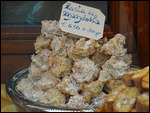





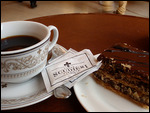
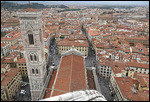
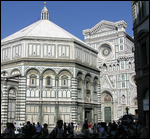
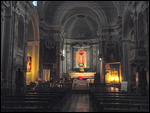
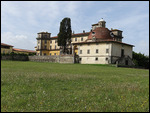

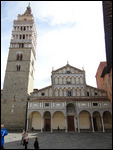
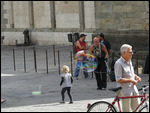
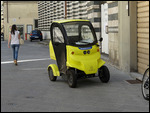
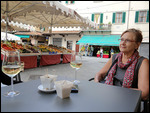
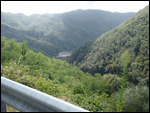
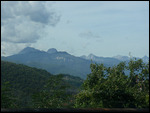

Gail and Naira
2013-09-21
Fabulous reading guys, we are getting visions of all this beautiful yummy food, you are making us salivate and all this amazing historical information absolutely wonderful. Agree Trish you are definitely the 'smart traveler' and Stu is obviously testing out those hips well and truly, running 100m (fast) and 463 big soldier steps OMG we wouldn't be worrying about the hips we would be more concerned about the ticker. Wonderful stories cant wait for the next entry. Take care 'and slow down' especially the one that's just had the significant birthday haha. Love it. ;-)